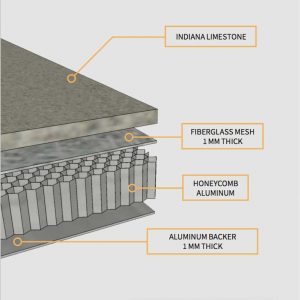Low maintenance costs

Current building design is primarily concerned with optimizing the construction costs and schedule of a project, while also ensuring the structure meets basic safety and serviceability requirements. The maintenance, alteration, replacement, and end-of-life costs associated with the support of the building after the initial construction process are often given less consideration in many types of commercial construction.
Therefore, the ultimate value and longevity of a building is largely dependent on its ability to be economically maintained and easily modified throughout its life. This is where lightweight limestone composite panels can provide value to building owners. Indiana limestone panels can be cleaned using conventional power-washing methods, and a damaged panel can be easily replaced without compromising the entire cladding system.
Sustainability
Lightweight limestone panels have several sustainable attributes making them advantageous to architects and designers seeking to achieve Leadership in Energy and Environmental Design (LEED) certification. Take, for example, the School of Informatics and Computing building on the campus of Indiana University. Designed by Connecticut-based architectural firm Pelli Clarke Pelli, in collaboration with the Indianapolis-based Ratio, the $39.8-million, 11,520-m2 (124,000-sf) building is clad with lightweight composite panels. The composite limestone panels are a positive contributor in the school’s quest to attain LEED Gold certification. Specific sustainable attributes of lightweight limestone panels include:
- aluminum portion of lightweight limestone panels can
be made of post-consumer recycled content, providing a sustainable option as well as points toward LEED certification; - lightweight limestone panels use less than 50 percent of the natural stone resources that 30-mm natural stone does to construct the same square footage, thereby reducing the environmental impact as well as resources lost from quarrying; and
- composite limestone panel systems offer durability, reduced energy costs by allowing for more insulation of the wall system, and space savings while lowering transportation costs in comparison with other building materials.
Limestone can help a building reflect heat. The solar reflectance index (SRI) gauges the ability of a constructed surface to reflect solar heat and is a composite measure combining a surface’s solar reflectance and emittance. Essentially, SRI is an indicator of how well a surface reflects (reflectance), and releases absorbed solar radiation (emittance). The lower the SRI, the hotter a material is likely to become in the sunlight. Designing with high-SRI materials such as Indiana limestone, can reduce the ‘heat island effect’ that cause cities to stay warmer and contributes to air pollution and increased energy consumption by air-conditioning systems.
Conclusion
Natural stone composite panels are a cost-effective cladding option providing the same beauty, durability, and low maintenance that has made limestone one of the most widely used building materials throughout history. By leveraging today’s technology, the industry has transformed this material into lightweight panels providing value to architects and designers, building owners, and installers as an economical, sustainable, and installer-friendly building material. These panels represent the next generation of high-performance cladding systems designed to be cost-effective and provide improved functionality, design flexibility, and the durability to construct buildings to stand the test of time.




